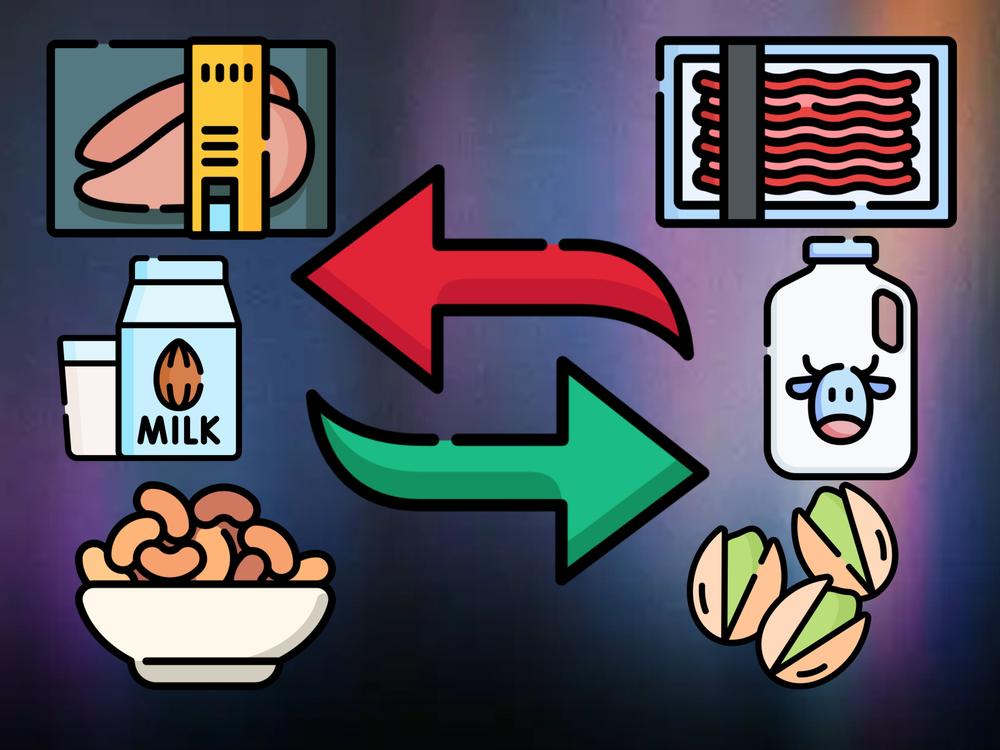
Common Ingredient Substitutions


Share on:
Introduction
Sometimes, you don’t have the exact ingredients for a recipe on hand; and that’s okay! You don’t need to follow a recipe to a tee (not even my own, I certainly don’t lol). Knowing how and when to do some simple ingredient swaps not only makes cooking easier and less stressful, but it will also make you a better cook, as you will learn to adapt your food on the fly.


Substitutions

.png)
Beans
I use cans of beans interchangeably. To me, all beans are the same; just a different color and shape (with minor nutritional differences). Put chickpeas in your chili, use black beans for hummus, put pinto beans in a salad, I don’t care; they’re all the same to me anyway:
- Black beans
- Black eyes peas
- Cannellini beans
- Chickpeas (garbanzo beans)
- Dark red kidney beans
- Fava beans
- Light red kidney beans
- Navy beans
- Pink beans
- Pinto beans

.png)
Flours
If you happened to read through my Water Absorption of Different Flours post, you’ll know what many flours absorb water differently than others. For example, if you’re making my Classic Chocolate Chip Cookies, you should reduce the flour from 240 g to 215 g if you are to replace the all purpose flour with whole wheat flour.

.png)
It sucks that I’m doing this list alphabetically, because this is probably the hardest swap. In general though, you can probably use the following flours interchangeably at a 1:1 ratio by volume without too much difference in taste or texture, as long as you’re not making a loaf of bread. Always add a little less than you originally would, and judge based on feel:
- Whole wheat flour
- Rye flour
- Spelt flour
- Oat flour
- Almond Flour
- Gluten free flour blend
The one exception I will point out is coconut flour, as it absorbs water about 4x as much as other flours. If you look up estimates (and based on my experiments in Water Absorption of Different Flours), you should use about 1/4 cup coconut flour to replace 1 cup of flour.


As they say: Cooking is an art, but baking is a science. Simply swapping one type of flour for another can cause some issues, but feel free to experiment and see what works best for you and your diet.


Grains
When I refer to grains here, I’m talking about some sort of carb base or side to your meal, such as pasta or rice. In place of pasta, all of the following below can be served in the same way, such as tossed with a sauce like Simple Pasta Sauce, Cottage Cheese Alfredo Sauce, or Oil Free Basil Pesto.
- Whole wheat pasta
- Chickpea pasta
- Red lentil pasta
- Spaghetti squash
- Zucchini noodles
- Roasted or sauteed vegetables
- Beans
- Lentils
- Shirataki noodles
- Shredded cabbage
- Bean sprouts


Yes, even some very non-traditional things like lentils or cooked vegetables can work well as a pasta replacement if you’re gluten free or want to lower your refined grain intake. Who says you can’t put pesto on beans and have a bowl of beans instead of a bowl of pasta?


The following are all great swaps for rice as well. As opposed to pasta (where you’d put a liquid sauce on them), rice would be mixed with dried spices, like in Classic Rice and Beans or Simple Cauliflower Rice.
- Brown rice
- Wild rice
- Quinoa
- Couscous
- Cauliflower, broccoli, or sweet potato rice
- Lentils
- Beans
- Barley
- Amaranth


Meat
As for substituting meat, you can realistically use any meat in place of another as long as you replace it 1:1 by weight. The easiest would be ground meat; all the following can be used interchangeably:
- Ground beef
- Ground turkey
- Ground pork
- Ground chicken breast
- Ground chicken thighs
- Ground lamb
- Tofu
- High Protein Veggie Ground


You can also replace chunks of meat (like diced chicken breast or thighs) with ground meat, and vise versa. Note that chicken breast is very lean, and thus should not be used for any long cooking dishes like Slow Cooker Chili or Chicken Noodle Stew. But as I showed in my Penne and Meat Casserole Bake, you can replace easily ground meat for Easy Baked Chicken Thighs. But any sort of dish where you sautee meat (like Nam Sod or Korean Chicken and Broccoli) can easily be swapped for anything else, from chicken breast, to ground turkey, to tofu.


Milk
A lot of my old baking recipes for example use unsweetened vanilla almond milk, but lately I’ve been opting for skim milk instead. I used to buy almond milk because it lasts longer, but I’ve been getting through milk quicker, and wanted the added nutrition of cow’s milk. Cow’s milk is cheaper while containing more protein and calcium. But really any of the following can be used at a 1:1 ratio, just note the calorie, fat, or taste differences. The same concept applies to yogurt as well:
- Whole milk
- 2% milk
- 1% milk
- Skim milk
- Unsweetened almond milk
- Unsweetened cashew milk
- Unsweetened oat milk
- Unsweetened rice milk
- Unsweetened coconut milk
- Unsweetened soy milk
- Unsweetened pea milk
- Water


As is the case with yogurt, always make sure to get anything labeled as “plain” or “unsweetened”. Many flavors like vanilla, chocolate, or strawberry are loaded with added sugars.


You can also make your own Homemade Plant Based Milk with oats, peanuts, almonds, etc. All these substitutes for milk should work just fine in your drinks, baking, and breakfast needs (such as Electrolyte Protein Shake, Chocolate Chip Date Cookies, and Omega-3 Yogurt Bowl).

.png)
Nut Butter
You should know by now that I love Natural Nut Butter. But you can make nut butters with way more than just peanuts; any type of nut or seed will work. Any the following can be used interchangeably (assuming you’re not allergic to nuts lol):
- Peanut butter
- Almond butter
- Cashew butter
- Pistachio butter
- Walnut butter
- Macadamia nut butter
- Sunflower seed butter
- Pumpkin seed butter
- Tahini
- Coconut butter


Nuts and Seeds
Just like with nut butter, all nuts and seeds can all be used interchangeably with minimal difference. Whether it be chopped nuts mixed into a dessert or breakfast, topping a salad with seeds, or using nuts in your pesto, the following can all be substituted at a 1:1 ratio:
- Peanuts
- Almonds
- Cashews
- Pistachios
- Walnuts
- Macadamia nuts
- Brazil nuts
- Pecans
- Pine nuts
- Hazelnuts
- Chia seeds
- Flax seeds
- Hemp seeds
- Sunflower seeds
- Pumpkin seeds
- Sesame seeds
- Poppy seeds
- Unsweetened shredded coconut


Speaking of pesto, I have been known to swap the pine nuts in pesto for whatever nuts I have on hand. I used pine nuts in my Avocado Pesto, but I’ve also used walnuts in Oil Free Basil Pesto, almonds in Lightened Extra Virgin Olive Oil Pesto, and even peanuts in Creamy Pesto Dip.

.png)
Sweeteners
Starting with liquid sweeteners, all of the following can be used 1:1 by volume. There may be slight differneces in weight (for example, 1/4 cup of honey is 84 g, but 1/4 cup of maple syrup is 80 g), but they’re all basically the same:
- Honey
- Maple syrup
- Sugar free syrup
- Molasses


Dates, or any other dried fruit (raisins, figs, etc.), can also be a great sweetener. A good ratio I’ve found is to make a date paste by blending 1/3 cup (80 g) hot water with 1/2 cup (80 g) dates. This should be about the same sweetness as 1/4 cup of honey or maple syrup. Note that you will have some extra liquid though, so you may need to reduce other liquid ingredients, or use more dry ingredients.


I’ve used dates as a sweetener in various desserts and snacks, such as my No Bake Energy Bites, Chocolate Chip Date Coookies, and Almond Date Brownies. Likewise, I’ve used liquid sweeteners like honey or maple syrup in my Double Chocolate Banana Bread, Peanut Butter Banana Pie, and Sweet Potato Blondies. Typically I reserve dates for any dessert that needs blending, whereas I’d opt for honey in something that simply gets mixed in a bowl. But swap in whatever you like, and adjust to taste for your desired sweetness.


As for granular sweeteners, if you are looking for a substitute for white sugar, any sort of granular low calorie sweetener will work. They can be replace 1:1 by volume for granulated sugar; examples include:
- Erythritol
- Allulose
- Stevia
- Monk fruit


I don’t typically use or buy granular sweeteners, but I have occasionally used them in the past. Examples include my Monk Fruit Rainbow Cookies or Amaretti Cookies with Monkfruit, where I simply swapped granulated sugar 1:1 with granulated monk fruit. I have been wanting to try and make my Classic Chocolate Chip Cookies with allulose and change nothing else to see what differences there are in taste or texture…maybe someday.


Vegetables
This might seem like an odd category, but hear me out. How often have you looked up a recipe that calls for a few different types of vegetables that you don’t have? If you know how to roast or sautee veggies, you can really swap out any vegetable for anything. I have a guide, Simply Roasted Vegetables, that has examples of a few vegetables and how long they’ll take to cook at 400F.


Here’s a list of some vegetables I’ve swapped around in the past. Feel free to experiment here; this is just a few examples I could come up with:
Raw Leafy Greans
- Romaine lettuce
- Spinach
- Kale
- Collard greens
- Mustard greens
- Arugula
- Cabbage
- Beet greans
- Mustard greens


Cooked Vegetables
- Peppers
- Onions
- Carrots
- Zucchini
- Yellow squash
- Eggplant
- Asparagus
- Artichokes
- Beets
- Mushrooms
- Tomatoes


Cruciferous Vegetables
- Broccoli
- Cauliflower
- Cabbage
- Brussel sprouts
- Kale
- Spinach
- Kohlrabi
- Bok choy
- Collard greens
- Mustard greens
- Watercress


Starchy Vegetables
- Sweet potatoes
- Yams
- Butternut squash
- Acorn squash
- Parsnips
- Plantains
- Rutabega
- Potatoes
- Corn


Noodle Replacements
- Spaghetti squash
- Zoodles
- Carrot noodles
- Butternut squash noodles
- Kelp noodles
- Shredded cabbage
- Bean sprouts
- Shirataki noodles

.png)
Yogurt
Finally, we’re on to yogurt. I pretty much always buy plain nonfat Greek yogurt, but nonfat cottage cheese is a common substitute for me as well. As with milk, any of the following fat percentages can be used interchangeably, with just small differences in taste and calories:
- Plain whole milk Greek yogurt
- Plain low fat Greek yogurt
- Plain nonfat Greek yogurt
- 4% fat cottage cheese
- 1% fat cottage cheese
- Nonfat cottage cheese


As is the case with milk, always make sure to get anything labeled as “plain” or “unsweetened”. Any sort of flavor, like strawberry, vanilla, or peach will all be loaded with added sugars
.png)
.png)
Image Sources
Flaticon
 Poor Man Protein
Poor Man Protein